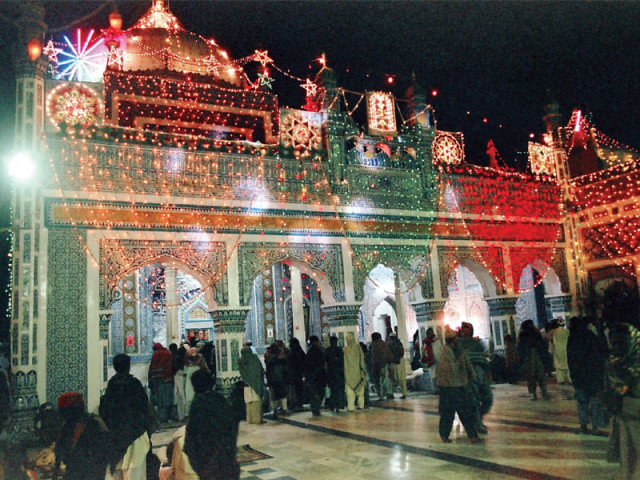In search of the sacred
Usual hustle and bustle was more electrifying with prospect of coming ‘urs’.

In search of the sacred
It took me twenty minutes to drive over to the tomb of the resting sage, adjacent to the scenic Kiran Lake. Eid, undoubtedly, is special for the countless people who come to celebrate it in Bhitt Shah. The usual hustle and bustle was all the more electrifying with the prospect of the coming ‘urs’ and the long Eid holidays, swelling the ranks of the ‘yatris’ who had come to pay their respects to the Shah.
Flags belonging to the Jeay Sindh Qaumi Mahaz (JSQM) lined Tambura Chowk and the town seemed to be teeming with life, as the Fazal Abbas Hotel hawked its renowned ‘doodh-pati’ and Shah Abdul Latif Photo Studio’s chotu made periodic announcements for available slots for photo shoots. As the shrine resonated with laughter, it was a testament to the devotion of the ‘commoners’ — Shah Abdul Latif’s chosen ones and the subjects of most of his poetry, who have not forgotten him even after so many decades.
It was compelling to see so much life filling up the darbar. No one was the master here. Distinctions between wadera and hari were meaningless and men and women were equal as they danced to the other-worldly tunes of the Dhambura, oblivious to their surroundings. The principal lesson of Islam and Sufism was too pervasive to be ignored.
After climbing the two flights of steps to the dargah, I entered the main courtyard of the tomb. At the very cusp of the entrance to the inner courtyard where the mosque is located, lies the Kirk tree. The origins of this tree go back to the time of Bhittai himself and legend has it that he planted the tree himself but the tree only became famous after the saint’s death.
Today, the tree can be seen adorned with locks, amulets and all sorts of oddities. “I placed a lock here eight months ago, so that my child would be safely delivered as I already had three miscarriages,” explained Firdous as she unlocked one of the locks on the branches. She had also arranged for a daig at the local langar since her mannat had been fulfilled.
However, the tree today seems to have faded over time, as if granting so many wishes had weakened it from the inside. “Its branches are now extremely weak, saeein,” said one of the caretakers of the dargah, “We occasionally trim the leaves but its regenerative capability has really become limited.”
Pakistani dargahs have always been associated with drugs and shady goings-on, and Bhitt Shah is no exception in that regard. In my brief interlude from the main shrine, I saw many people sharing a chilum, smoking hashish and on a couple of occasions, having a go at heroin too. “What harm am I doing to society if I am high for a little while? It is malangi dhuaan after all,” says Jahangir Bhagio, a fruit seller.
When I inquired as to the source of his drug supplies, he exchanged a nervous glance with his partner. “Saeein, it is easily available here. So much so, that people share it on the basis of ‘charity.’ I got my share today for just exchanging a bunch of bananas.” His “share” is more than 100 grams of lower grade hashish.
Similarly, people have always wondered about the shady ‘musafirkhanas’ which adorn the top of the bazaar outside the dargah. Everybody was tightlipped on what went on in the musafirkhannas. “We are never told as to what happens there. Who comes to these places in night time and for what purpose?” said Rehman, a fruit vendor.
When questioned as to what he thought it was, he said that these might be safe places for sexual encounters rather than being permanent brothels. “Saeein, I think prostitutes are also settled in some of these, pretending to be permanent musafirs,” quips his friend Rashid.
Although exorcisms usually take place as the need arises, their numbers multiply during specific times of the year such as during Eid and Muharram. Qader Buksh Khaskeli, the Kunjidar (key-keeper) of the dargah, has been handling such cases for more than two decades now.
“He is the master of his art. When the tamburas (long-necked plucked lute) are plucked and Lateef Saeein’s bayts are sung coupled with invocations of Solomon, the djinn has to abandon the human,” asserts one close aide. Khaskeli, himself, however takes no credit for that and claims that it is the ‘karamat’ of Bhittai himself.
“In night time, we treat people who have come from all across the interior. Tambura is the instrument of the saints and yogis. Shah is the sanctuary for everyone, even for djinns,” said Khaskeli adding that after separating the djinn from the human, the former are allowed to play within the dargah vicinity for a month. They leave of their own accord.
“Everybody comes here with hopes. None return empty-handed,” explains a Mutawalli at the exit of the shrine. The Bhitt is eternal in that sense. It is one set of glorious traditions and values which has proved resolute in the face of changing times.
Published in The Express Tribune, Sunday Magazine, April 15th, 2012.

















COMMENTS
Comments are moderated and generally will be posted if they are on-topic and not abusive.
For more information, please see our Comments FAQ